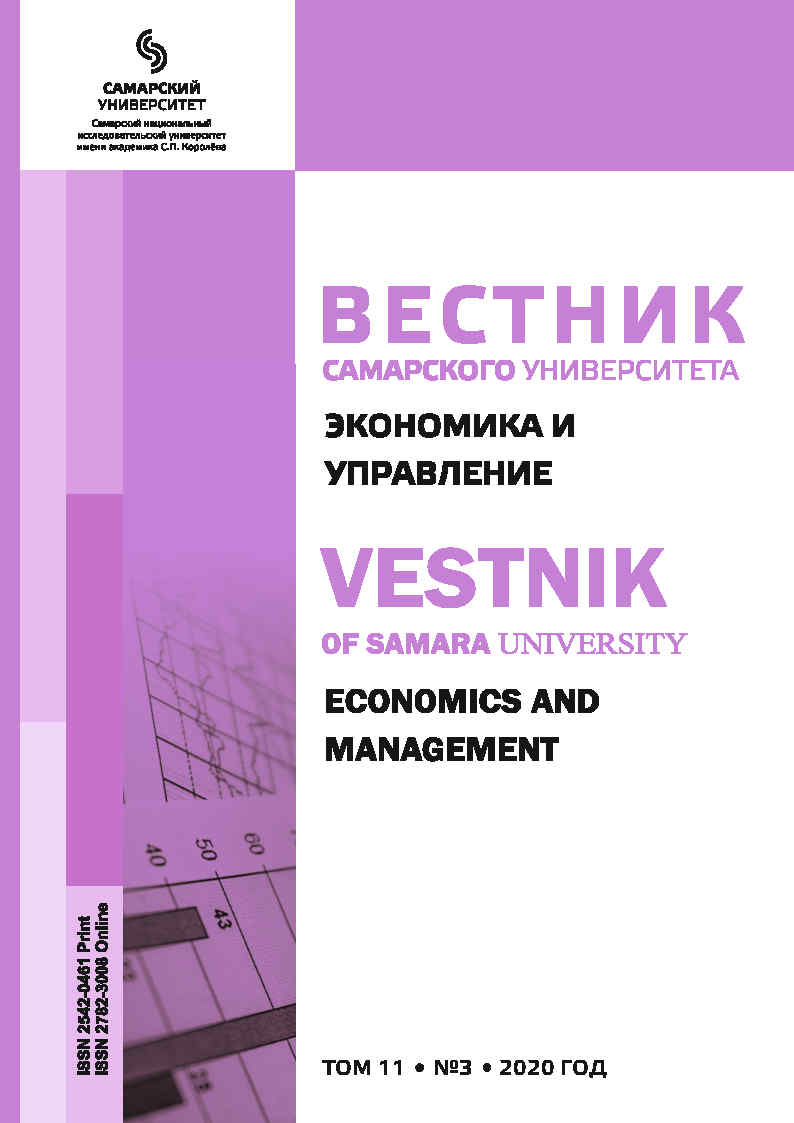РЕГИОНАЛЬНЫЕ ОТРАСЛЕВЫЕ ЦИКЛЫ И УСТОЙЧИВОСТЬ ЭКОНОМИКИ РЕГИОНА
- Авторы: Хмелева Г.А.1, Семенычев В.К.1, Коробецкая А.А.1
-
Учреждения:
- Самарский государственный экономический университет
- Выпуск: Том 11, № 3 (2020)
- Страницы: 190-202
- Раздел: МАТЕМАТИЧЕСКИЕ И ИНСТРУМЕНТАЛЬНЫЕ МЕТОДЫ ЭКОНОМИКИ
- URL: https://journals.ssau.ru/eco/article/view/8152
- DOI: https://doi.org/10.18287/2542-0461-2020-11-3-190-202
- ID: 8152
Цитировать
Полный текст
Аннотация
Рост и сокращение времени циклов является характерным признаком современной экономики. Все чаще циклический фактор служит причиной дисбаланса и нарушения устойчивости мировой и национальной экономики. Вместе с тем не изучен вопрос об асинхронности региональных отраслевых циклов. Ранее считалось, что региональный отраслевой цикл, его стадии роста и падения, согласуется с национальным. В статье показано, что именно асинхронность региональных отраслевых циклов лежит в основе дисбаланса и снижает устойчивость экономического развития страны. Представленное авторами исследование расширяет границы понимания закономерностей спадов и подъемов отраслевых циклов, поскольку раскрывает причины и последствия асинхронности отраслевых циклов в российских регионах. Терминологически региональный отраслевой цикл следует трактовать как динамический процесс колебаний экономической активности в рамках жизненного цикла отрасли, характеризующийся повторяемостью последовательных этапов спада и подъема в отрасли региона. Авторами разработана классификация основных параметров регионального отраслевого цикла по их циклическим свойствам, включающая опережающие, запаздывающие и совпадающие с динамикой цикла индикаторы. Представлено обобщение научно-методологических подходов к отраслевым циклам как риск-фактору устойчивого и сбалансированного развития регионов. Определены причины и последствия региональных отраслевых циклов для устойчивости экономики региона. Практическую значимость будут иметь предложенные для органов региональной власти мероприятия по предупреждению негативных последствий сдвига фазы отраслевого регионального цикла.
Ключевые слова
Об авторах
Галина Анатольевна Хмелева
Самарский государственный экономический университет
Автор, ответственный за переписку.
Email: galina.a.khmeleva@yandex.ru
доктор экономических наук, профессор, заведующий кафедрой мировой экономики
РоссияВалерий Константинович Семенычев
Самарский государственный экономический университет
Email: 505tot@mail.ru
доктор экономических наук, профессор, профессор кафедры цифровых технологий и решений
РоссияАнастасия Александровна Коробецкая
Самарский государственный экономический университет
Email: kaa.sseu@yandex.ru
кандидат экономических наук, доцент кафедры цифровых технологий и решений
РоссияСписок литературы
- Российские регионы в условиях санкций: возможности опережающего развития экономики на основе инноваций: монография / под общ. ред. Г.А. Хмелевой. Самара: Изд-во Самар. гос. экон. ун-та, 2019. 446 с.
- Semenychev V., Khmeleva G., Kozhukhova V. The Evolution of Technical Efficiency of Russian Regions in 2011–2016: SFA Stochastic Analysis Method with Spatial Effects // SSRN 2018. DOI: http://dx.doi.org/
- 2139/ssrn.3245728 (дата обращения: 28.03.2019).
- Слуцкий Е.Е. Сложение случайных величин как источник циклических процессов // Вопросы конъюнктуры. 1927. Т. 3, Вып.1. C. 27–33.
- Иванов П.А. Особенности циклического развития региональной экономики // Проблемы современной экономики. 2010. № 1 (1). С. 176–181. URL: https://cyberleninka.ru/article/n/osobennosti-tsiklicheskogo-razvitiya-regionalnoy-ekonomiki.
- Беркович М.И., Комарова Е.А. Отраслевой анализ в контексте эволюционного развития экономических систем // Экономические и социальные перемены: факты, тенденции, прогноз. 2014. № 1 (31). C. 72–81. DOI: http://doi.org/10.15838/esc/2014.1.31.7.
- Чернавский Д.С., Никитин А.П., Чернавская О.Д. О возникновении распределения Парето в нелинейных динамических системах // Биофизика. 2008. Т. 53, № 2. C. 351–358. URL: https://www.
- elibrary.ru/item.asp?id=7. Семенычев В.К., Коробецкая А.А. Многомодельная оценка инновационного развития 78 российских регионов по опережающим индикаторам за период 2005–2017 гг. (Препринт SSRN). DOI: http://dx.doi.org/10.2139/ssrn.3373579.
- Цветков В.А. Циклы и кризисы: теоретико-методологический аспект. Санкт-Петербург: Нестор-История, 2013. 504 с.
- Myrdal G. Economic Theory and Underdeveloped Regions. Hutchinson; London, 1964. 168 c.
- Petrakos G., Rodriguez-Pose A., Rovolis A. Growth, integration, and regional disparities in the European Union // Environment and Planning А. 2005. Vol. 37 (10). P. 1837–1857. DOI: http://doi.org/10.1068/a37348.
- Petrakos G., Saratsis Y. Regional inequalities in Greece // Papers in Regional Science. 2000. № 79. С. 57–74. DOI: http://doi.org/10.1007/s101100050003.
- Rodriguez-Pose R., Fratesi U. Regional business cycles and the emergence of sheltered economies in the southern periphery of Europe // Growth and Change. 2007. № 38. С. 621–648. DOI: http://dx.doi.org/10.1111/j.1468-2257.2007.00390.x.
- Победин А.А. Федулов Д.В., Летаева Т.В. Теории и инструменты контрциклического регулирования региональных экономических систем // Вопросы управления. 2017. № 1 (44). С. 79–89. URL: https://www.elibrary.ru/item.asp?id=30770620.
- Rötheli T.F. Should business rely on business cycle forecasting? // Central European Journal of Operations Research. 2018. Vol. 26. Р. 121–133. DOI: http://doi.org/10.1007/s10100-017-0477-8.
- Porter M.E. Competitive Strategy: Techniques for Analyzing Industries and Competitors. New York: Free Press, 1998. 397 p. URL: https://kniga.biz.ua/pdf/250-competitive-strategy.pdf.
- Gartner W.B. Who is an Entrepreneur? Is the Wrong Question // American Journal of Small Business. 1988. Vol. 12(4). P. 11–32. DOI: http://doi.org/10.1177/104225878801200401.
- Fritsch M. Start-ups in Innovative Industries – Causes and Effects. Handbook of Research on Innovation and Entrepreneurship. Chaltenham: Elgar, 2011. P. 365–381. DOI: https://doi.org/10.4337/9781849807760.00033.
- Хансен Э. Экономические циклы и национальный доход. Москва: Изд-во иностр. лит., 1959. 243 с.
- Сафиуллин М.Р., Ельшин Л.А., Абдукаева А.А. Оценка инклюзивности региональных циклических колебаний экономики в макроциклы (на примере регионов Приволжского федерального округа) // Научный результат. Экономические исследования. 2019. Т. 5, Вып. 3. С. 19–34. DOI: http://doi.org/10.18413/2409-1634-2019-5-3-0-3.
- Хмелева Г.А. Интеграция отдельных регионов в систему мирохозяйственных связей // Журнал экономической теории. 2019. Т. 16, № 4. С. 746–757. DOI: http://doi.org/10.31063/2073-6517/2019.16-4.11.
- Stimson R.J., Stough R.R., Roberts B.H. Regional Economic Development: Analysis and Planning Strategy. Springer Science & Business Media, 2006. 452 p. DOI: http://doi.org/10.1007/3-540-34829-8.
- Kim D., Hong S. Regional business cycles and employment resilience in Korean regions // Area Development and Policy. 2019. Vol. 4, Issue 3. P. 236–251. DOI: http://doi.org/10.1080/23792949.2018.1537718.
- Lucas R.E. Understanding Business Cycles. В книге: Estrin S., Marin A. (Eds.) Essential Readings in Economics. Palgrave; London, 1995. P. 306–327. DOI: http://doi.org/10.1007/978-1-349-24002-9_17.
- Neffke F., Henning M., Boschma R., Lundquist K.-J., Olander L.-O. The Dynamics of Agglomeration Externalities along the Life Cycle of Industries // Regional Studies. 2011. Т. 45, Issue 1. С. 49–65. DOI http://doi.org/10.1080/00343401003596307.
- Хаберлер Г. Процветание и депрессия: теоретический анализ циклических колебаний. Челябинск: Социум, 2005. 474 с.
- Градов А.П. Цикличность развития экономики и управление конкурентными преимуществами. Санкт-Петербург: Полторак, 2011. 1150 с.
- Львова Н.А., Абрамишвили Н.Р Гипотеза о влиянии отраслевых циклов на инвестиционную активность российских предприятий // Известия СПбГЭУ. 2019. № 5–2 (119). С. 66–91. URL: https://www.elibrary.ru/item.asp?id=41442917.
- Семенычев В.К., Коробецкая А.А., Кожухова В.Н. Предложения экономического инструментария моделирования и прогнозирования эволюционных процессов. Самара: САГМУ, 2015. 384 с.
- Semenychev V.K., Kurkin E.I., Semenychev E.V., Danilova A.A. Multimodel forecasting of non-renewable resources production // Energy, 2017, no. 130, рp. 448–460. DOI: http://doi.org/10.1016/j.energy.2017.04.098.
Дополнительные файлы









